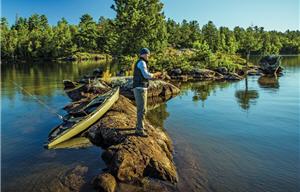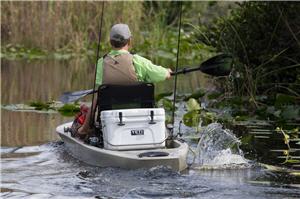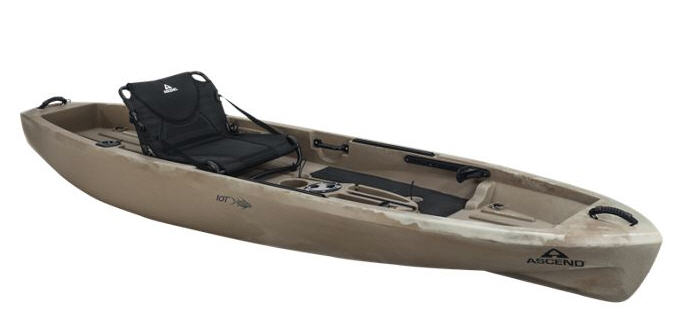
Kayaks are great fishing craft, better than a boat in a lot of situations. For small ponds or waters with limited access, a kayak is a great way to get on the water and after fish. These little boats also are good for many rivers where shallows keep larger boats out.
 Besides, fishing from a kayak is a blast! They are a fun boat for fishing, exploring or just heading out to do a paddle.
Besides, fishing from a kayak is a blast! They are a fun boat for fishing, exploring or just heading out to do a paddle.
Choosing the right one can be difficult simply because there are so many kayaks on the market. Do you want a sit-in or a sit-on-top? Short or long? One built for fast water or flat? Fiberglass or plastic? Inflatable or wood?
 Read enough about how to choose the right kayak, and you’ll soon be overwhelmed with a lot of good information. There are two kinds of stability, at least eight kinds of material from which a kayak can be built and yaks built for ocean touring, fast water acrobatics, camping and other types of water sports.
Read enough about how to choose the right kayak, and you’ll soon be overwhelmed with a lot of good information. There are two kinds of stability, at least eight kinds of material from which a kayak can be built and yaks built for ocean touring, fast water acrobatics, camping and other types of water sports.
![]() Tip: Take this fun Quiz: Chris Payne’s Everything You Wanted to Know About Kayaks & Fishing to test your knowledge and learn new tips, tricks, and must knows before getting back in the water with your kayak.
Tip: Take this fun Quiz: Chris Payne’s Everything You Wanted to Know About Kayaks & Fishing to test your knowledge and learn new tips, tricks, and must knows before getting back in the water with your kayak.
First, answer these five questions before you start.
1. How Much are You Willing to Pay for a Kayak?
Pick a price you can afford to pay then buy a boat that costs less. That way you can afford to buy the extras—paddle, anchor trolley, stake-out pole, drift sock, depthfinder, and so on.
Accessories you must have include a paddle (duh), PFD or Life Jacket suited for kayaks, a kayak cart for hauling the boat to the water where there is no launch and other safety gear.
2. Where are You Going to Fish?
 Identify the waters you want to fish because that will define the size of the kayak.
Identify the waters you want to fish because that will define the size of the kayak.
Small waters that see little wind don’t need a large boat for safety reasons. Larger lakes and the ocean need a bigger craft, which really makes sense, right? Will you be paddling a long ways, or just enough to put the kayak in the right place?
Longer kayaks are more efficient, speaking from a boat-design standpoint, so if you need to paddle quite a bit in the course of a day’s fishing, then a longer boat may be a better choice.
Also, longer and wider kayaks are more stable than shorter boats. Plus, larger boats have more capacity and offer more buoyancy than shorter, narrower kayaks.
 |
| Malone Autoloader Car Kayak Carrier |
3. How Will You Transport the Kayak?
Will you haul it in the back of a pickup or on top of the car? Is a trailer possible?
Cartopping is one of the reasons many folks buy a kayak because it’s an inexpensive way to get on the water. That’s when the weight of the kayak is important. Sit-in kayaks generally are lighter than sit-ons because of the extra material used in the latter.
Most kayaks will load easily into the back of a pickup truck, but if the truck is a shortbed or the kayak is over 12 feet, then a kayak trailer is a better option. However, receiver hitch extenders are available for added support.
 |
| Malone Xtralight V-Style Double Kayak Trailer |
4. What Physical Limitation do You Have?
If mobility is an issue, that can determine which style of kayak will suit you best.
In my case, I’m tall, and getting into and out of a sit-in kayak is difficult unless the launching area is perfect. I’ve found that a sit-on-top kayak is the best choice for me as it’s easy to get into and out of after a day of fishing.
But as noted above, I’d find it difficult to load it onto the top of a full-size SUV because of its weight.
5. What Kind of Fishing Will You be Doing?
If you’re a bass fisherman or chasing after fish where a lot of gear is necessary, not to mention a cooler for fish, your lunch and the assorted gear—including the extra rods!-- that goes with fishing, then you need a kayak with a lot of open storage. That means a kayak intended for two people (not the best choice because it can be hard to paddle), or a sit-on-top with its large cargo areas.
![]() Tip: Shop Kayak accessories at Bass Pro Shops here
Tip: Shop Kayak accessories at Bass Pro Shops here
However, if you’re a fly fisherman who can carry most of his gear in a vest and only uses one rod, then a sit-in kayak might be the best choice.
Now the Four Points.
Once you answer those questions, it’s time to go shopping. Bass Pro Shops and Cabela’s both are handy references to see the types of kayaks that are available, and they make initial research easy. Following are points to consider.
1. Kayak Safety
The most important thing to look for in a kayak is safety. You need a boat that fits the water you’ll be fishing. As noted above, bigger water dictates a bigger boat to be safer. A bigger you also dictates a bigger boat, both for comfort as well as buoyancy and stability.
2. Kayak Comfort
Comfort is the second-most important consideration simply because you want a kayak that you’ll enjoy fishing out of and being in.
 |
| Ascend FS10 Sit-In Angler Titanium Kayak |
Again, size of the kayak is important for comfort, especially if you’re going to be spending long hours in it. Larger boats generally are more stable, and they make a beginning kayaker more confident of staying in the boat.
3. Design
For most fishing applications, it’s a toss-up between sit-in kayaks and the newer sit-on-top boats. The sit-ins are the traditional kayak. They offer protection from the elements, are drier because of the cover of the front and rear decks and are a touch more stable because the paddler is sitting closer to the water.
 |
| Ascend 10T Sit-On-Top Desert Storm Kayak |
Sit-on-top kayaks are more open, with the paddler sitting on the inner hull, and often enough on a raised seat. They provide easy access to gear placed fore and aft of the seat. While heavier than a similar sit-in kayak (because of the inner hull), they provide ease of entry, making them the best choice for older anglers or those with some mobility problems.
4. Paddle, Pedal or Propeller?
With the exponential growth in interest in kayaks comes innovation. Gone are the days when the only means of propulsion is a kayak paddle. Now there are kayaks that have propellers that are linked to either a hybrid trolling motor or a set of bicycle pedals.
Also, there is the Hobie Mirage paddle drive. All these offer faster speed and greater range along with a significantly higher purchase price.
For the first-time kayak fisherman, especially one who isn’t sure if he will really like the narrow boats, it makes sense to buy a less-expensive boat without the alternate propulsion.
Good Luck!
Answer the questions and ponder the points, all will help you choose the kayak that’s right for you.
- 4810 views

